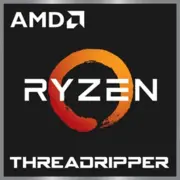AMD Ryzen Threadripper 7970X

AMD Ryzen Threadripper 7970X: Power for Professionals
Reviewing the flagship processor for workstations and extreme tasks.
1. Key Specifications: Architecture, Performance, and Key Features
Storm Peak Architecture and TSMC 5 nm Process
The AMD Ryzen Threadripper 7970X is built on the Zen 4 architecture (codename Storm Peak) and manufactured using TSMC's 5-nanometer FinFET process. This provides high transistor density and energy efficiency, despite a record number of cores — 32 (64 threads).
Performance: Extreme Multithreaded Potential
The processor shows impressive results in tests:
- Geekbench 6 Single-Core: 2914 — an excellent score for work tasks that require quick response times.
- Geekbench 6 Multi-Core: 24,797 — an absolute advantage in rendering, simulations, and coding.
- L3 Cache 128 MB (shared across all cores) speeds up the processing of large datasets, for example, when working with 3D models in Blender.
Key Features
- Support for PCIe 5.0: 88 PCIe lanes for connecting multiple graphics cards, NVMe drives, and peripherals.
- AMD Technologies: Precision Boost Overdrive (PBO) for automatic overclocking, AMD EXPO for memory optimization.
- TDP 350 W: Requires serious cooling, but justifies its energy consumption with performance.
2. Compatible Motherboards: Sockets and Chipsets
sTR5 Socket
The Threadripper 7970X uses the new sTR5 socket, which is physically larger than AM5. This means that older coolers for previous generation Threadrippers will not fit — a model with sTR5 mounting is required (e.g., Noctua NH-U14S TR5).
TRX50 and WRX90 Chipsets
- TRX50: Basic chipset for workstations. Supports 4 channels of DDR5, overclocking, and 4 PCIe 5.0 x16 slots. Example boards: ASUS Pro WS TRX50-SAGE WIFI.
- WRX90: Designed for professional tasks. Adds support for ECC memory, more SATA/USB ports, and extended virtualization capabilities (e.g., ASUS ROG Zenith II Extreme).
Tip: When choosing a board, pay attention to VRM heatsinks — the processor requires stable power.
3. Supported Memory: Only DDR5
The Threadripper 7970X works exclusively with DDR5 memory, supporting quad-channel mode.
- Recommended frequency: 5200–6000 MHz.
- For work tasks (rendering, virtualization), an optimal volume is 128–256 GB (8 modules of 32 GB each).
Important: Activating EXPO (analogous to XMP) in BIOS speeds up memory configuration without manual adjustments.
4. Power Supply Units: Power Calculation
With a TDP of 350 W and the appetite of a high-performance graphics card (e.g., NVIDIA RTX 4090), the minimum recommended power supply wattage is 1000 W. For systems with multiple GPUs or large storage arrays — 1200–1500 W.
Selection Criteria:
- 80+ Platinum/Titanium certification (efficiency ≥92%).
- Support for ATX 3.0 standard with 12VHPWR cable for modern graphics cards.
- Modular design: Convenience in cable management within the case (examples: Corsair AX1600i, Seasonic PRIME TX-1300).
Experience: Under load (rendering + 2 GPUs), the system consumes up to 800–900 W. Don't skimp on the power supply — unstable power can damage components.
5. Pros and Cons of the Threadripper 7970X
Pros
- Best-in-class multithreaded performance.
- Support for PCIe 5.0 and DDR5.
- Optimization for professional software (AutoCAD, Maya, Unreal Engine).
Cons
- Price: Starting from $2500 (processor only).
- Limited selection of motherboards (top models starting from $600).
- Noisy cooling system under load.
6. Use Cases
Work Tasks
- 3D Rendering: In Redshift or V-Ray, 32 cores will reduce render times from hours to minutes.
- Video Editing: Edit 8K footage in DaVinci Resolve without lag.
- Virtualization: Run dozens of VMs for software testing.
Gaming
Despite its potential, the processor is overkill for gaming. In most titles (e.g., Cyberpunk 2077), frame rates will bottleneck at the graphics card. However, in simulators (Microsoft Flight Simulator) with mods, 64 threads will ensure stability.
Multimedia
Processing RAW photos in Lightroom + streaming in 4K — the processor will handle it without dropping FPS.
7. Comparison with Competitors
Intel Core i9-14900K
- 24 cores (8P+16E), but lags in multithreaded tasks by 30–40%.
- Better in gaming due to high clock speeds (up to 6.0 GHz).
Intel Xeon W9-3495X
- 56 cores, but at a higher price ($6000+), TDP 350 W.
- Excels in specialized tasks (CAD), but lags in energy efficiency.
Conclusion: The Threadripper 7970X is well-balanced in price and performance for creative professionals.
8. Practical Assembly Tips
1. Case: Full-size Tower (e.g., Lian Li PC-O11 Dynamic XL) with 6–8 fans.
2. Cooling: Custom liquid cooling with a 360mm radiator (Thermaltake Toughliquid Ultra) or a top-tier air cooler (be quiet! Dark Rock Pro TR5).
3. Cables: Use sleeving for improved airflow.
4. Testing: Before installing the OS, check stability with AIDA64 (24-hour stress test).
9. Final Conclusion: Who is the Threadripper 7970X For?
This processor is made for:
- Professionals: 3D designers, engineers, video enthusiasts.
- Enthusiasts: Those building a system for future upgrades.
- Corporate Users: Servers for rendering or computing.
Why this one? No other processor in its class offers so many cores for the price. If you need absolute results right now — this is a choice without compromise.
P.S. When building a PC with the Threadripper 7970X, remember: it's an investment in speed. But for everyday tasks or gaming, there are more budget-friendly options.
Basic
CPU Specifications
Memory Specifications
GPU Specifications
Miscellaneous
Benchmarks
Compared to Other CPU
Share in social media
Or Link To Us
<a href="https://cputronic.com/cpu/amd-ryzen-threadripper-7970x" target="_blank">AMD Ryzen Threadripper 7970X</a>